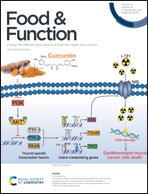Different types of components obtained from Monascus purpureus with neuroprotective and anti-inflammatory potentials†
Abstract
The mold Monascus has been used as a natural food coloring agent and food additive for more than 1000 years in Asian countries. In Chinese herbology, it was also used for easing digestion and antiseptic effects. Through a thorough investigation of a citrinin-free strain: M. purpureus BCRC 38110, four azaphilones, three benzenoids, one benzofuranone, one 5′,6′-dihydrospiro[isochromane-1,2′-pyran]-4′(3′H)-one derivative, two steroids, and six tetralones have been successfully identified. Among them, monapyridine A (1), monatetralones A–E (2–6), and monabenzofuranone (7) were first reported. Their structures were characterized by 1D and 2D NMR, UV, IR, and HRESIMS analyses. With a series of bioactivity screening, monascuspirolide B (14) and ergosterol peroxide (16) exhibited concentration-dependent attenuation of the paclitaxel-induced neurite damage of mouse dorsal root ganglion neurons. The interleukin (IL)-1β-induced release of inflammatory cytokines IL-8 and tumor necrosis factor (TNF)-α in human chondrosarcoma cells was inhibited by monapurpureusone (8) and monascuspirolide B (14). Altogether, M. purpureus BCRC 38110 possessed potentials as natural therapeutics against inflammatory osteoarthritis and paclitaxel-induced neurotoxicity.



 Please wait while we load your content...
Please wait while we load your content...